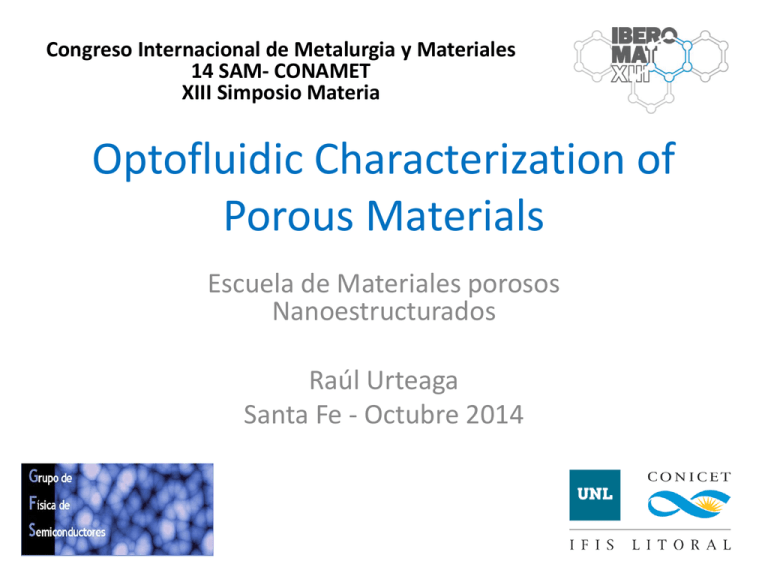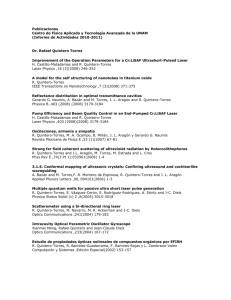Caracterización óptofluídica de materiales
advertisement

Congreso Internacional de Metalurgia y Materiales 14 SAM- CONAMET XIII Simposio Materia Optofluidic Characterization of Porous Materials Escuela de Materiales porosos Nanoestructurados Raúl Urteaga Santa Fe - Octubre 2014 Optofluídica Integración de la óptica y la microfluídica para obtener información de ambas en simultaneo [1]. Caracterización óptofluídica de materiales: _ Longitud de onda incidente mucho mayor que el tamaño de las estructuras: Índice de refracción efectivo _ Interferencia coherente de haces: Capas delgadas _ Imbibición capilar de líquidos en matriz porosa: Fluidodinámica [1] Psaltis et al. “Developing optofluidic technology through the fusion of microfluidics and optics.” Nature 2006, 442, 381−386. Thin film optical interference For P- type polarization F.L. Pedrotti, L.S. Pedrotti “Introduction to optics” 2nd Ed. Prentice-Hall inc. NJ (1993) Thin film optical interference Boundary Conditions: Tangential components of magnetic and electric field are continuos across the interface The relation between fields at the interfaces can be expressed in a matrix form Which depends upon the phase difference: and the ‘‘admitance’’ of the film F.L. Pedrotti, L.S. Pedrotti “Introduction to optics” 2nd Ed. Prentice-Hall inc. NJ (1993) Transfer Matrix formalism For a multilayer we have: The reflection and transmission coefficients are Can be calculated as F.L. Pedrotti, L.S. Pedrotti “Introduction to optics” 2nd Ed. Prentice-Hall inc. NJ (1993) Results for Normal Incidence For this case we have: d 1 t T where R n0 The total reflectance will be: Here the phase difference is: 𝛿= 2𝜋𝑛1 𝑑 𝜆0 n1 n2 Results for Normal Incidence 𝛿= 2𝜋𝑛1 𝑑 𝜆0 d => Periodic! Important to note: 1 t (If δ is real ) T R n0 𝑛1 𝑑 = 𝜆0 4 𝑛1 𝑑 = 𝜆0 2 n1 n2 Results for Normal Incidence If reflectance is periodic, then the Fourier transform in K space is discrete, and have peaks at 2nd 2𝑛1 𝑑 If there is absortion (refractive index complex) Optical Properties of Mixtures How to obtain the effective dielectric constant? To find these variables Maxwell's equations must be solved for electrostatic : Geometry must be known and generally requires an expensive calculation Effective Medium Theories • Maxwell-Garnet 𝜀𝑙 Cavidad [2] 𝑬 paralelo al eje 𝜀𝑗 𝑬 perpendicular Esfera ⅓ ⅓ Cilindro 0 ½ Placa 1 0 Elipsoide de ejes 𝑙𝑎 , 𝑙𝑏 y 𝑙𝑐 [2] O. Stenzel, The Physics of Thin Film Optical Spectra Springer Series in Surface Sciences Volume 44 (2005) Effective Medium Theories • Lorentz- Lorenz [2] 𝜀𝑙 = 1 𝜀𝑗 • Bruggeman [2] 𝜀𝑙 = 𝜀 𝜀𝑗 • Looyenga-Landau-Lifshithz [3] 𝜀𝑙 ~𝜀𝑗 𝜀𝑗 [2] O. Stenzel, The Physics of Thin Film Optical Spectra Springer Series in Surface Sciences Volume 44 (2005) [3] L.D. Landau, E.M. Lifshitz, Electrodynamics of Continuous Media, 2nd. Edition (vol. 8), Elsevier, Burlington, 1984. Effective Medium Theories Limits 𝑬 paralell 𝑬 Perpendicular Esfer ⅓ ⅓ Cylinder 0 ½ Plate 1 0 Cavidad [2] Effective Medium Theories 7 Silicon nreal 6 Silicon nimag Alumina 5 Refractive index of silicon and alumina [4]. 4 Alumina is transparent! 3 𝑛= 𝜀 2 1 0 200 300 400 500 600 700 [nm] [4] 800 900 1000 1100 1200 Effective Medium Theories Example case I: 4 Porous Silicon + Air 3.5 Effective refractive index @𝜆 = 1000𝑛𝑚 L=1/3 Maxwell-Garnet Bruggeman Looyenga 3 2.5 2 1.5 1 0 0.1 0.2 0.3 0.4 0.5 0.6 Porosity 0.7 0.8 0.9 1 Effective Medium Theories @𝜆 = 1000𝑛𝑚 L=1/2 1.7 1.6 Effective refractive index Example case II: Porous Alumina + Isopropyl Alcohol Depolarization factor L: 0.5 1.8 1.5 1.4 1.3 Maxwell-Garnet dry alumina Maxwell-Garnet wet alumina Bruggeman dry alumina Burggeman wet alumina 1.2 1.1 1 0 0.1 0.2 0.3 0.4 0.5 0.6 Porosity 0.7 0.8 0.9 1 Optical Characterization Spectroscopic reflectance of porous Silicon single layer Optical Characterization Spectroscopic reflectance of porous Silicon Bragg reflector Spectroscopic Liquid Infiltration method (SLIM) 1) Using FFT of the reflectance spectrum we can obtain an estimation of the optical width of the dry sample Porous Alumina + Isopropyl Alcohol Depolarization factor L: 0.5 1.8 1.7 𝑛𝑑𝑟𝑦 𝑑 Effective refractive index 1.6 1.5 2) After infiltration we can measure the optical width of the wetted sample 1.4 1.3 1.1 1 𝑛𝑤 𝑑 Maxwell-Garnet dry alumina Maxwell-Garnet wet alumina Bruggeman dry alumina Burggeman wet alumina 1.2 0 0.1 0.2 0.3 0.4 𝑛𝑤 = 𝑓 𝑃, 𝑛𝐴𝑙 , 𝑛𝑙𝑖𝑞 0.5 0.6 Porosity 0.7 0.8 0.9 1 𝑛𝑑𝑟𝑦 = 𝑓 𝑃, 𝑛𝐴𝑙 , 𝑛𝑎𝑖𝑟 3)The system can be solved to obtain P and d M. J. Sailor Porous Silicon in Practice Preparation, Characterization and Applications Wiley-VCH Verlag & Co. (2012) Fluid Mechanics at low Re I) Capillary filling of uniform closed channel Laplace Pressure Straight channel 2r ∆𝑃 = Contact Angle 𝜎 𝑐𝑜𝑠𝜃 𝑟 Hagen-Poisseuille flow Tortuous channel: L 𝜏= L’ In nondimensional form: 𝐿 𝐿′ were L.N. Acquaroli, R. Urteaga, C.L.A. Berli, R.R. Koropecki, Langmuir 27, 2067 (2011) Fluid Mechanics at low Re I) Uniform closed channel Solving the differential equation: Lucas-Washburn Dynamics 1 𝜎𝑟 𝑙2 = 𝑡 2 𝜇 𝑖𝑓 𝛼 → 0 then 𝑥 ∗ → 𝑡 ∗ The final position defines the value of 𝛼 Edward W. Washburn “THE DYNAMICS OF CAPILLARY FLOW” The Physical Review Vol. XVII, 3, (1921) Posición Menisco 𝛼 𝑖𝑓 𝑡 → ∞ then 𝑥 ∗ → 1+𝛼 L 0 Tiempo tfill Optoflidic Characterization Porous Silicon Lateral view Top view Dynamic SLIM Experimental setup What is measured (twice) Normalized reflectance during the imbibition of a PS layer (15 μm thick, fabricated using a current density of 13 mA/cm2), with isopropyl alcohol at room temperature and the pressure of 1 atm. L.N. Acquaroli, R. Urteaga, C.L.A. Berli, R.R. Koropecki, Langmuir 27, 2067 (2011) Relation between reflexion extremes and liquid infiltration An extreme in reflectance will occur each time the optical path is a multiple of 𝜆/4: 𝜆0 𝑒0 = 𝑚 4 𝐿 𝑒0 = 0 𝑛𝑒𝑓𝑓 𝑥 𝑑𝑥 𝑒0 = 𝑛2 (𝐿 − 𝑥) + 𝑛3 𝑥 𝑑𝑒0 = 𝑥(𝑛3 − 𝑛2 ) 𝑑𝑥 Between extremes in reflectance the interface moves Δ𝑥 ∶ 𝑛1 𝑑 = 𝛥𝑥 = 𝜆 4(𝑛3 − 𝑛2 ) 𝜆0 4 𝑛1 𝑑 = 𝜆0 2 Results L.N. Acquaroli, R. Urteaga, C.L.A. Berli, R.R. Koropecki, Langmuir 27, 2067 (2011) Results _Obtaining this values from the fit, it is posible to calulate the mean hidraulic radius and the tortuosity. _ The porosity and layer thicknes it is also obtained by SLIM 𝜏= 𝐿 ~2,6 𝐿′ Fluid Mechanics at low Re I) Variable section open channel Poisseuille flow 𝜕𝑝 8𝜇𝑄 − = 𝜕𝑥 𝜋𝑟 4𝑥 Laplace Pressure 𝛥𝑝 = 2𝛾 cos𝜃 𝑟𝑥 Direct problem: 𝑢 𝑙 =𝛼 𝑟 −3 𝑙 𝑙 −4 𝑟 d𝑥 0 𝑥 were 𝛼= 𝛾cos(𝜃) 4𝜇 R. Urteaga, L.N. Acquaroli, R.R. Koropecki, A. Santos, M. Alba, J. Pallares, L.F. Marsal, C.L.A. Berli, Langmuir 29, 2784 (2013) Fluid Mechanics at low Re I) Variable section open channel Inverse problem [5]: 𝑢 𝑟 𝑙 𝑙 as input = 𝑟 𝐿 𝑢 1 𝐿 3 1 + 3𝛼 𝐿 𝑢 𝑙 4 3 𝑙 dl −1 3 𝑢𝑙 𝑄 𝑣 as input 𝑟 𝑣 = 𝑟 5 5 𝑄 𝑉 𝑉 5 + 2 𝜋 𝛼 𝑉 𝑣 𝑄6𝑣 dv 1 5 𝑄−1 𝑣 Has multiple solutions!! [5] E. Elizalde, R. Urteaga, R.R. Koropecki, C.L.A. Berli, Phys. Rev. Lett. 112, 134502 (2014) Optoflidic Characterization Porous Alumina Top side Bottom side Experimental setup E. Elizalde, R. Urteaga, R.R. Koropecki, C.L.A. Berli, Phys. Rev. Lett. 112, 134502 (2014) Optoflidic Characterization Porous Alumina Results Radii at the ends coincide with SEM photographs E. Elizalde, R. Urteaga, R.R. Koropecki, C.L.A. Berli, Phys. Rev. Lett. 112, 134502 (2014) Thanks Relation between reflexion extremes and liquid infiltration 𝐿 𝑒0 = 0 𝑛𝑒𝑓𝑓 𝑥 𝑑𝑥 𝑒0 = 𝑛2 (𝐿 − 𝑥) + 𝑛3 𝑥 𝑑𝑒0 = 𝑥(𝑛3(x) − 𝑛2(𝑥) ) 𝑑𝑥 An extreme in reflectance will occur each time the optical path is a multiple of 𝜆/4: 𝜆0 𝑒0 = 𝑚 4 Between extremes in reflectance the interface moves Δ𝑥 ∶ 𝜆 𝜆 𝛥𝑥 = = 4(𝑛3(𝑥) − 𝑛2(𝑥) ) 4(𝑛𝑤(𝑥) − 𝑛𝑑𝑟𝑦(𝑥) ) 𝑛1 𝑑 = 𝜆0 4 𝑛1 𝑑 = 𝜆0 2 The linear approximation Porous Alumina + Isopropyl Alcohol Relative difference from linear Depolarization factor L: 0.5 1.8 Modelo de Bruggeman. Depolarization factor: 0.5 0 1.7 -0.01 Relative diference Effective refractive index 1.6 1.5 1.4 1.3 -0.03 -0.04 Maxwell-Garnet dry alumina Maxwell-Garnet wet alumina Bruggeman dry alumina Burggeman wet alumina 1.2 1.1 1 -0.02 0 0.1 0.2 0.3 0.4 0.5 0.6 Porosity -0.05 0.7 0.8 0.9 0 0.2 0.4 0.6 Porosity 1 𝑛𝑤 − 𝑛𝑑𝑟𝑦 = 𝑓 𝑃 ~(𝑛𝑙𝑖𝑞𝑢𝑖𝑑 −1)𝑃 𝛥𝑥 = 𝜆 4(𝑛3(𝑥) − 𝑛2(𝑥) ) 0.8 1
